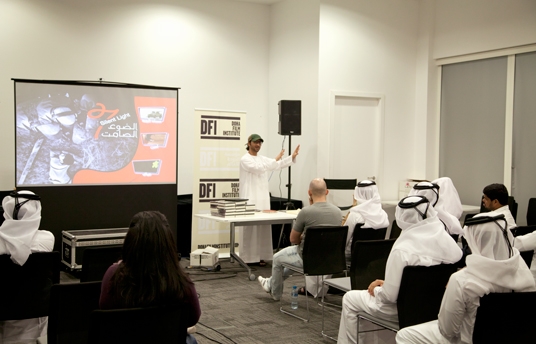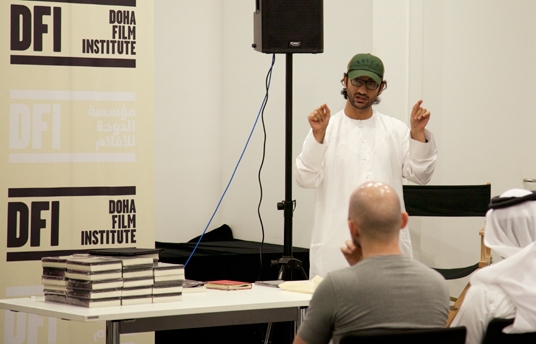5 Steps to make a Short Film
Sep 05, 2012

Compiled By Anealla Safdar
Photos By Raymond Bobar
Around 50 aspiring filmmakers have completed Films Tawash – a four day workshop on how to produce a short film.
Hosted by Doha Film Institute’s Gulf Development Unit and led by Emirati director Abdallah Hassan Ahmed, the students analysed four of his short films from script to screen: “Tinback”, “Soora Naqesa”, “Sabeel” and “Asghar Min Alsama’a”.
Did they leave with an idea of how to produce their own short film?
We went along and asked them to take us through five key steps:
1. Pre-production

Nada Al Saadi
Nada Al Saadi, 25, Graphic Designer at Al Jazeera
“Pre-production is preparation, preparation and preparation. You have to be organised to allow yourself to be creative later.
This stage includes finding a location and casting. Casting in Doha can be very difficult – finding actors is hard. You don’t have a big range to choose from. You need to do this well in advance so give yourself lots of time. Work with actors to make sure they are committed so that you don’t have any last minute cancellations. It’s key to build a relationship.
Finding a location is tricky. Here, you need permission to film almost everywhere. This procedure takes a long time, and you might need to call on connections.”
2. Production
Reem Talal, 23, Media student at Qatar University
“Production includes organising the budget, issuing the daily call sheet, organising equipment and making sure what has been prepared in pre-production happens. The filming team must stick to the timetable and not fall too far behind schedule.
The important people in this part of the process include the production manager, producer, production assistants, driver and the best boy.
At this stage as director, you would need to make sure everyone is doing their role perfectly and monitor the budget.”
3. Post-production
Teeba Ghadi, 31, Freelance video editor
“Post-production is about assembly.
Editors take care of how the film looks and sounds. This includes colour correction, grading, visual effects and sound mixing.
If your film-length is 15 minutes, this process could take anything from four hours to one week, depending on the number of problems. Sometimes you may have to shoot a scene again if it’s missing or not good enough, but you should try and figure out alternatives in post-production.
This is a time when you need to find solutions. You need a lot of patience and focus. As an editor, you could be in a room for 10 hours a day. Sometimes the director will come and discuss with you, so you need to know what’s expected from you. You have to maintain an interest.”
4. Printing

Hamza Rustom
Hamza Rustom, 24, Radiographer
“When printing, you need to keep the film’s format in mind. There could be different needs for each festival you pitch to.
Printing also includes the marketing of the film, which would have been included in your budget. You need to work with a graphic designer to make a film poster.
There are also many ways of modern marketing; social media is a huge platform and you can reach from east to west.
This stage is about strategy and is the producer’s job.”
5. Festivals

Abdallah Al Kuwari
Abdullah Al Kuwari, 16, Student at Khalifa Independent School
“Festivals allow you to show your film to the people; you need to be ready to hear peoples’ opinions.
You submit online to the festival’s website and wait to hear if your film has been accepted.
Even if it’s not chosen for competition, it might get a screening at the event.
At this stage, you need to be calm. You must be ready for rejection. If you don’t get accepted, keep trying other festivals. Don’t give up. Audiences also might not understand why your film is important, and you may need to explain it to them.”
